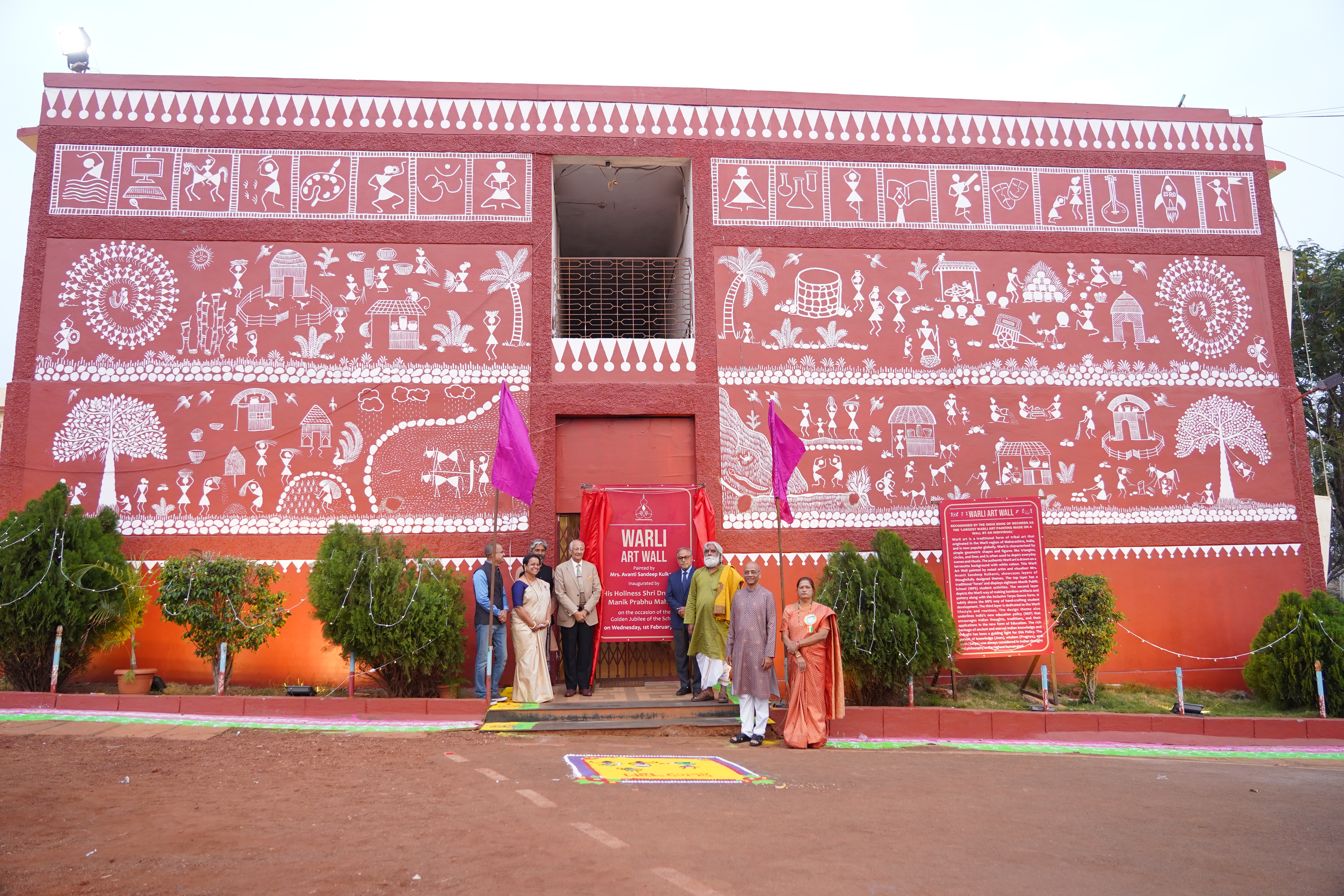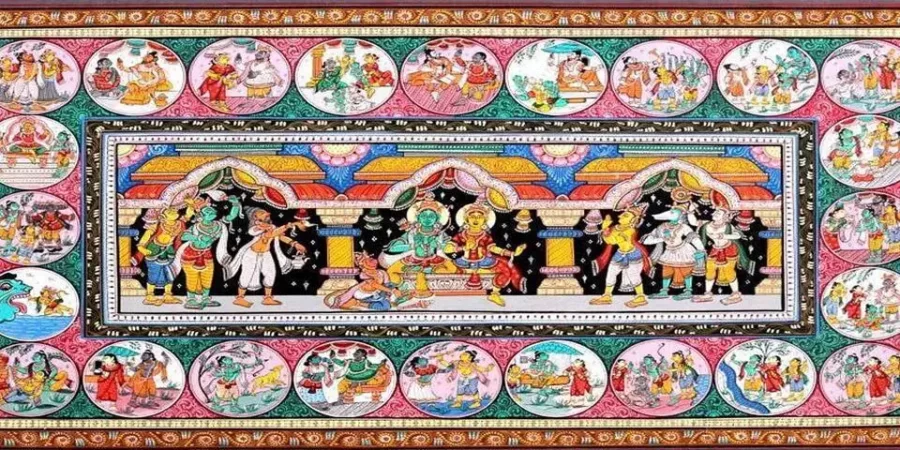Dive into the vibrant world of Indian art with a journey through the diverse traditional painting styles that have shaped the cultural fabric of the subcontinent. From the ancient allure of Madhubani Painting, tracing its roots back to the Satya Yuga, to the exquisite opulence of Tanjore Painting flourishing under the Nayakas of Thanjavur, each art form unfolds a unique tale.
Join us in exploring the intricate details of Miniature Painting, the simplicity of Warli Art, the mythological narratives of Pattachitra, and more. As the writer of www.thetrendingpeople.com, let me guide you through the cultural narratives, historical significance, and enduring beauty that define these traditional treasures through our research. Uncover the essence of India's artistic legacy and witness the timeless craftsmanship that makes these art forms a testament to the nation's creative spirit.
1. Madhubani Painting
Madhubani Artwork, source: commons.wikimedia.org
Madhubani Painting, also known as Mithila Painting, originated in Bihar's Madhubani district and has a rich history dating back to ancient times, even to the Satya Yuga in Hinduism. A focus of devotion to gods, nature, and flora is prevalent in these paintings, primarily created by women. The artwork often portrays gods surrounded by women, trees, and natural elements, reflecting the artists' desire for spiritual connection and oneness with the divine.
2. Miniature Painting
The Mughal miniature painting; Image Source: blog.emamichisel.com
Miniature painting is a meticulous and small-scale art form that involves creating finely detailed portraits on materials like vellum, prepared card, copper, or ivory. The word "miniature" comes from the use of minium, a red lead pigment commonly used by medieval illuminators. This art form emerged from the blending of traditions found in illuminated manuscripts and medals, thriving from the early 16th century until the mid-19th century. Originating around the 16th and 17th centuries during the Mughal era, the roots of miniature painting date back to the 7th century. These artworks are characterized by their diminutive size and often depict scenes from courts, hunting, battlegrounds, receptions, and more. The art form incorporates three distinct styles: Indian, Persian, and Islamic.
3. Warli Painting
Manik Public School, Maniknagar, Karnataka, India, Warli art wall painting
image source: commons.wikimedia.org
Warli painting, one of the oldest Indian art forms, dates back to 3000 BCE and finds its origins in the Warli tribe. This tribe resides in the western ghats of India, primarily in the Nasik and Thane districts of Maharashtra.
Warli paintings uniquely capture the tribe's daily life, showcasing activities like weddings, farming, praying, hunting, and dancing. The art form's simplicity is evident in its minimalistic approach, predominantly using white squares and triangles on yellow, brown, or red backgrounds.
This tribal art primarily emerges from the North Sahyadri Range in Maharashtra, covering areas like Dahanu, Talasari, Jawhar, Palghar, Mokhada, and Vikramgad in the Palghar district. While it originated in Maharashtra around 3000 BCE, Warli painting remains a vibrant practice in the region to this day.
4. Pattachitra
"Pattachitra," derived from Sanskrit, translates to 'image on canvas,' where 'Patta' signifies canvas and 'Chitra' denotes image or painting. Originating in the Indian states of Orissa and West Bengal, this art form dates back to the 5th or 7th century.
In Pattachitra paintings, Lord Krishna is frequently depicted and heavily influenced by the Vaishnava cult. Patachitra is a comprehensive term encompassing traditional, cloth-based scroll paintings prevalent in the eastern Indian states of Odisha, West Bengal, and parts of Bangladesh.
Renowned for its intricate details and rich narratives, Pattachitra commonly portrays mythological stories and folktales. Originating as ritualistic art and souvenirs for pilgrims visiting Puri and other Odisha temples, Patachitras are integral to ancient Bengali narrative art, originally employed as visual aids during song performances.
5. Kalamkari
"Immerse yourself in the rich artistry of Kalamkari, an ancient Andhra Pradesh tradition. Adorn your space with a traditional cloth painting depicting a timeless Bhagavad Gita scene, where Krishna imparts wisdom to Arjuna."; Image Source: blog.emamichisel.com
Kalamkari, meaning 'drawings with the pen' or 'pen-art,' is an artistic tradition originating in Andhra Pradesh, India. There are two main styles of Kalamkari painting: Machilipatnam and Srikalahasti.
The Machilipatnam style, named after its place of origin, involves block printing on fabric. On the other hand, the Srikalahasti style, originated from the Chittoor district in Andhra Pradesh, relies on freehand penwork on fabric. Both styles showcase the rich cultural heritage of the region and have distinct techniques, with Machilipatnam emphasizing block printing and Srikalahasti highlighting the use of a pen for intricate detailing.
6. Phad Painting
Image Source: trocals.com
Phad Painting, named after the 30 or 15 feet-long canvas or fabric called 'phad,' originated in the state of Rajasthan thousands of years ago. This traditional art form depicts stories of battles, hunting, and adventures, employing vibrant colors such as red, yellow, and orange.
Notably, Phad paintings often portray the folk deities Pabuji and Devnarayan, capturing the rich cultural and historical narratives of the region. The elongated canvas serves as a unique canvas for these intricate and storytelling artworks, showcasing the artistic heritage of Rajasthan.
7. Tanjore Painting
Image source: commons.wikimedia.org
Tanjore Painting, also known as Thanjavur Painting, has its origins in the Thanjavur district of Tamil Nadu, dating back to 1600 AD. This traditional Indian art form emerged during the Chola regime and thrived under the Nayakas of Thanjavur. Tanjore paintings are created on wooden planks called "Palagai Padam" and are influenced by Maratha, Deccani, and European styles.What sets this art form apart is the opulent use of gold foil in the painting process, adding a distinctive richness and charm to the artwork. Tanjore Painting stands as a testament to the artistic legacy of the region.
8. Kalighat Painting
Kalighat Painting, Kolkata, India, 1875, entitled "Brahmin Kneeling Before Two Tigers: Image source Wikipedia
Kalighat Painting, also known as Bengal Pat, emerged in the 19th century near the Kalighat Kali Temple in Kolkata, West Bengal. Initially, these paintings depicted mythological themes with gods and goddesses but later evolved to address social issues.
Crafted on cloth or patta, Kalighat paintings took a transformative turn, becoming a tool for social reform. Artists began creating pieces that raised awareness about societal concerns, portraying scenes like priests with unchaste women or corrupt cops accepting bribes. These paintings of the 19th and early 20th centuries are characterized by bold outlines, vibrant colors, and minimal background details. The Victoria and Albert Museum in London houses the world's largest collection of Kalighat paintings, showcasing 645 pieces, including watercolors, line drawings, and hand-painted lithographs.
9. Gonda Painting
Image Source: Gaon Connection
Gond Painting, originating 1400 years ago from the Gond tribe in Madhya Pradesh, represents one of the largest tribes in India. This traditional art form is a unique gift to nature, as Gond paintings exclusively feature depictions of flora and fauna.
Originally, artisans crafted these vibrant artworks using natural materials such as leaves, cow dung, plant sap, and colored soil. In contemporary times, acrylic paints have become more commonly used in the creation of Gond paintings. This artistic tradition stands as a testament to the Gond tribe's deep connection with nature and their distinctive contribution to India's rich cultural heritage.
10. Mysore Painting

Mysore Painting is a prized traditional South Indian art style that originated in and around Mysore, Karnataka. The Vijayanagara Empire, this classical form of painting was encouraged by the Mysore emperors.
Distinct for their beauty, texture, and subtlety, Mysore paintings often depict stories from Hindu mythology and feature the elegance characteristic of classical Indian art. The development of Mysore painting is intertwined with the broader history of art in Karnataka, reaching back to the Ajanta Caves period (2nd century BC to 6th century AD). Following the fall of the Vijayanagara Empire, artists migrated to places like Mysore, Tanjore, and Surpur, blending local traditions to evolve unique styles such as Mysore painting.
11. Rajput Painting
Rajput Painting, also known as Rajasthan art, gained prominence in the 17th century in the region of Rajputana in northern India. Emerging from artists expelled from the Mughal court who were well-versed in the Mughal miniature tradition, this style drew inspiration from regional painting traditions, particularly those portraying Hindu epics like the Mahabharata and Ramayana.
Rajput painting covered a diverse range of subjects, including portraits of the royal family engaged in activities like hunting or everyday life, scenes from Hindu mythology, and stylized depictions of unidentified individuals. The artists employed a rich palette extracted from minerals, plant sources, shellfish, and precious stones. Additionally, silver and gold were used to enhance the opulence of these exquisite artworks.
12. Cheriyal Scrolls
Image source: mapacademy
Cheriyal Scrolls, a unique and stylized form of Nakashi art, have been preserved by the Nakashi family across generations in the former Telangana region. Originating from the rich artistic traditions of Telangana, these scrolls draw influence from both the long scroll tradition and Kalamkari art, presenting a more stylized version of Nakashi art.
Comprising approximately 50 panels akin to modern comic strips, Cheriyal Scrolls distinguish themselves with their vivid colors and imaginative depictions. In contrast to the traditional rigor seen in Tanjore or Mysore paintings, these scrolls play a crucial role in narrating stories from Indian mythology, particularly the Puranas and Epics. Historically prevalent across Andhra and other regions, Cheriyal Scrolls now find their last outpost in the town of Cheriyal, Telangana, as newer forms of entertainment have become prevalent.
13. Mughal Painting
Image source: Wikipedia
Mughal Painting, an exclusive form of South Asian art, emerged during the 16th to 18th centuries at the court of the Mughal Empire in North India (modern-day India and Pakistan). Predominantly crafted as miniatures for book illustrations or standalone pieces stored in albums, Mughal painting has its roots in Persian miniature painting with some influence from Chinese art.
A distinct art form owned by Muslim Mughal monarchs, it depicts battles, tales, hunting scenes, animals, royal life, and mythology. The Mughal rulers played a pivotal role in spreading Muslim artistic traditions, notably Persian influences, across South Asia.
14. Pichwai Painting
Image source: thepurpleturtles.com
Pichwai Painting, derived from the Sanskrit words "Pichh" for "back" and "wais" for "hanging," refers to large holy Hindu paintings, typically on fabric, portraying Krishna. The term translates to "that which hangs from the back." These paintings are prominently featured in Pushtimarg-style Hindu temples, such as the Shrinathji Temple in Nathdwara, Rajasthan.
Pichwais serve a specific purpose beyond aesthetics: they hang behind the deity Shrinathji, a localized representation of Krishna central to Pushtimarg devotion, symbolizing his divine activities. The city of Aurangabad is also associated with Pichwai paintings.
These artworks play a crucial role in communicating Krishna's tales to individuals who may be unable to read or write. The collections of diverse images in temples are periodically updated to align with the calendar of religious feasts honoring the deity.
15. Kerala Mural
Mural paintings in the Vaikom Temple; Image source: Wikipedia
Kerala Mural paintings are vibrant frescoes depicting Hindu mythology, integral to Kerala's artistic tradition. Dating back to the 9th to 12th centuries CE, these murals received royal patronage in Kerala's temples and palaces.
Despite facing challenges, including hardships and a threat of extinction during the British colonial period, Kerala's native mural artists experienced a revival of their traditions after India gained independence in 1947. Some of the earliest examples of Kerala's unique mural style are found in the paintings of Tiruvanchikulam and the Thirunanthikarai Cave Temple, now part of Tamil Nadu.
The scriptural foundation for these paintings is rooted in Sanskrit texts like Chithrasoothram, Tantrasamuchaya, Abhilashitartha Chintamani, and Silparatna. These texts provide insights into the iconography of the mythological characters depicted in the murals. Notably, the Chitrasutra, part of the Vishnu Dharmottara Purana, serves as a detailed guide, offering answers to various questions about the purpose, role, and relationship of painting with artists and connoisseurs.


















